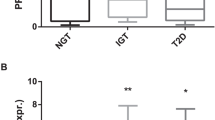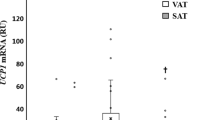Abstract
Objective:
Insulin resistance in visceral obesity is substantially driven by adipose tissue inflammation, particularly by macrophages accumulating in obese adipose tissue. In contrast, adipose tissue macrophages express the hemoglobin scavenger receptor (CD163) and heme oxygenase-1 (gene: HMOX1) that together protect from oxidative stress. Our aim was to evaluate the expression of CD163 and HMOX1 in intra-abdominal visceral (omental) and subcutaneous adipose tissue as well as circulating soluble CD163 concentrations in human obesity and its association with adipose tissue inflammation, body fat distribution and insulin resistance.
Methods:
CD163, HMOX1 and CD68 mRNA expression in visceral and subcutaneous adipose tissue, serum concentration of soluble CD163 in morbidly obese patients (body mass index (BMI) >40 kg m−2), who underwent laparoscopic surgery for gastric banding (n=20), matched for age and sex to controls (BMI<30 kg m−2; n=20) was analyzed.
Results:
CD163 expression was highly upregulated in human adipose tissue and soluble CD163 serum concentration was elevated in obese vs lean subjects. HMOX1 was upregulated in adipose tissue by obesity as well and expressed predominantly in macrophages. Although CD163 expression strictly correlated with macrophage abundance, HMOX1 was additionally upregulated within macrophages. This upregulation was significantly lower in visceral compared with subcutaneous adipose tissue. Strikingly, relative visceral adipose tissue expression of HMOX1 negatively correlated with waist-to-hip ratio and the homeostasis model assessment of insulin resistance (both P=0.024).
Conclusions:
Visceral obesity is associated with defective upregulation of heme oxygenase-1 in visceral adipose tissue. A lack of this antioxidative and anti-inflammatory enzyme in visceral adipose tissue could contribute to the development of insulin resistance.
This is a preview of subscription content, access via your institution
Access options
Subscribe to this journal
Receive 12 print issues and online access
$259.00 per year
only $21.58 per issue
Buy this article
- Purchase on Springer Link
- Instant access to full article PDF
Prices may be subject to local taxes which are calculated during checkout




Similar content being viewed by others
References
Despres JP, Lemieux I . Abdominal obesity and metabolic syndrome. Nature 2006; 444: 881–887.
Kahn SE, Zinman B, Haffner SM, O'Neill MC, Kravitz BG, Yu D et al. Obesity is a major determinant of the association of C-reactive protein levels and the metabolic syndrome in type 2 diabetes. Diabetes 2006; 55: 2357–2364.
Kim CS, Park HS, Kawada T, Kim JH, Lim D, Hubbard NE et al. Circulating levels of MCP-1 and IL-8 are elevated in human obese subjects and associated with obesity-related parameters. Int J Obes (Lond) 2006; 30: 1347–1355.
Hotamisligil GS, Shargill NS, Spiegelman BM . Adipose expression of tumor necrosis factor-alpha: direct role in obesity-linked insulin resistance. Science 1993; 259: 87–91.
Fain JN . Release of Interleukins and Other Inflammatory Cytokines by Human Adipose Tissue Is Enhanced in Obesity and Primarily due to the Nonfat Cells. Vitam Horm 2006; 74: 443–477.
Weisberg SP, McCann D, Desai M, Rosenbaum M, Leibel RL, Ferrante Jr AW . Obesity is associated with macrophage accumulation in adipose tissue. J Clin Invest 2003; 112: 1796–1808.
Xu H, Barnes GT, Yang Q, Tan G, Yang D, Chou CJ et al. Chronic inflammation in fat plays a crucial role in the development of obesity-related insulin resistance. J Clin Invest 2003; 112: 1821–1830.
Cancello R, Henegar C, Viguerie N, Taleb S, Poitou C, Rouault C et al. Reduction of macrophage infiltration and chemoattractant gene expression changes in white adipose tissue of morbidly obese subjects after surgery-induced weight loss. Diabetes 2005; 54: 2277–2286.
Curat CA, Wegner V, Sengenes C, Miranville A, Tonus C, Busse R et al. Macrophages in human visceral adipose tissue: increased accumulation in obesity and a source of resistin and visfatin. Diabetologia 2006; 49: 744–747.
Zeyda M, Farmer D, Todoric J, Aszmann O, Speiser M, Gyori G et al. Human adipose tissue macrophages are of an anti-inflammatory phenotype but capable of excessive pro-inflammatory mediator production. Int J Obes (Lond) 2007; 31: 1420–1428.
Harman-Boehm I, Bluher M, Redel H, Sion-Vardy N, Ovadia S, Avinoach E et al. Macrophage infiltration into omental versus subcutaneous fat across different populations: effect of regional adiposity and the co-morbidities of obesity. J Clin Endocrinol Metab 2007; 92: 2240–2247.
Gordon S . Alternative activation of macrophages. Nat Rev Immunol 2003; 3: 23–35.
Zeyda M, Stulnig TM . Adipose tissue macrophages. Immunol Lett 2007; 112: 61–67.
Bourlier V, Zakaroff-Girard A, Miranville A, De Barros S, Maumus M, Sengenes C et al. Remodeling phenotype of human subcutaneous adipose tissue macrophages. Circulation 2008; 117: 806–815.
Moestrup SK, Moller HJ . CD163: a regulated hemoglobin scavenger receptor with a role in the anti-inflammatory response. Ann Med 2004; 36: 347–354.
Schaer DJ, Alayash AI, Buehler PW . Gating the radical hemoglobin to macrophages: the anti-inflammatory role of CD163, a scavenger receptor. Antioxid Redox Signal 2007; 9: 991–999.
Abraham NG, Drummond G . CD163-Mediated hemoglobin-heme uptake activates macrophage HO-1, providing an antiinflammatory function. Circ Res 2006; 99: 911–914.
Otterbein LE, Soares MP, Yamashita K, Bach FH . Heme oxygenase-1: unleashing the protective properties of heme. Trends Immunol 2003; 24: 449–455.
Moller HJ, Aerts H, Gronbaek H, Peterslund NA, Hyltoft Petersen P, Hornung N et al. Soluble CD163: a marker molecule for monocyte/macrophage activity in disease. Scand J Clin Lab Invest Suppl 2002; 237: 29–33.
Aristoteli LP, Moller HJ, Bailey B, Moestrup SK, Kritharides L . The monocytic lineage specific soluble CD163 is a plasma marker of coronary atherosclerosis. Atherosclerosis 2006; 184: 342–347.
Axelsson J, Moller HJ, Witasp A, Qureshi AR, Carrero JJ, Heimburger O et al. Changes in fat mass correlate with changes in soluble sCD163, a marker of mature macrophages, in patients with CKD. Am J Kidney Dis 2006; 48: 916–925.
Li M, Kim DH, Tsenovoy PL, Peterson SJ, Rezzani R, Rodella LF et al. Treatment of obese diabetic mice with a heme oxygenase inducer reduces visceral and subcutaneous adiposity, increases adiponectin levels, and improves insulin sensitivity and glucose tolerance. Diabetes 2008; 57: 1526–1535.
Ndisang JF, Lane N, Jadhav A . The heme oxygenase system abates hyperglycaemia in Zucker Diabetic Fatty rats by potentiating insulin-sensitizing pathways. Endocrinology 2009; 150: 2098–2108.
Matthews DR, Hosker JP, Rudenski AS, Naylor BA, Treacher DF, Turner RC . Homeostasis model assessment: insulin resistance and beta-cell function from fasting plasma glucose and insulin concentrations in man. Diabetologia 1985; 28: 412–419.
Huber J, Kiefer FW, Zeyda M, Ludvik B, Silberhumer GR, Prager G et al. CC chemokine and CC chemokine receptor profiles in visceral and subcutaneous adipose tissue are altered in human obesity. J Clin Endocrinol Metab 2008; 93: 3215–3221.
Kiefer FW, Zeyda M, Todoric J, Huber J, Geyeregger R, Weichhart T et al. Osteopontin expression in human and murine obesity: extensive local up-regulation in adipose tissue but minimal systemic alterations. Endocrinology 2008; 149: 1350–1357.
Fain JN, Madan AK, Hiler ML, Cheema P, Bahouth SW . Comparison of the release of adipokines by adipose tissue, adipose tissue matrix, and adipocytes from visceral and subcutaneous abdominal adipose tissues of obese humans. Endocrinology 2004; 145: 2273–2282.
Despres JP, Lemieux I, Prud′homme D . Treatment of obesity: need to focus on high risk abdominally obese patients. Br Med J 2001; 322: 716–720.
Meigs JB, Nathan DM, Wilson PW, Cupples LA, Singer DE . Metabolic risk factors worsen continuously across the spectrum of nondiabetic glucose tolerance. The Framingham Offspring Study. Ann Intern Med 1998; 128: 524–533.
Cotrim HP, Carvalho F, Siqueira AC, Lordelo M, Rocha R, De Freitas LA . Nonalcoholic fatty liver and insulin resistance among petrochemical workers. JAMA 2005; 294: 1618–1620.
Ye J . Emerging role of adipose tissue hypoxia in obesity and insulin resistance. Int J Obes (Lond) 2009; 33: 54–66.
Trayhurn P, Wood IS . Adipokines: inflammation and the pleiotropic role of white adipose tissue. Br J Nutr 2004; 92: 347–355.
Wiesener MS, Maxwell PH . HIF and oxygen sensing; as important to life as the air we breathe? Ann Med 2003; 35: 183–190.
Bernhardt WM, Wiesener MS, Weidemann A, Schmitt R, Weichert W, Lechler P et al. Involvement of hypoxia-inducible transcription factors in polycystic kidney disease. Am J Pathol 2007; 170: 830–842.
Cinti S, Mitchell G, Barbatelli G, Murano I, Ceresi E, Faloia E et al. Adipocyte death defines macrophage localization and function in adipose tissue of obese mice and humans. J Lipid Res 2005; 46: 2347–2355.
Carey DG, Jenkins AB, Campbell LV, Freund J, Chisholm DJ . Abdominal fat and insulin resistance in normal and overweight women: direct measurements reveal a strong relationship in subjects at both low and high risk of NIDDM. Diabetes 1996; 45: 633–638.
Rabe K, Lehrke M, Parhofer KG, Broedl UC . Adipokines and insulin resistance. Mol Med 2008; 14: 741–751.
Kim DH, Burgess AP, Li M, Tsenovoy PL, Addabbo F, McClung JA et al. Heme oxygenase-mediated increases in adiponectin decrease fat content and inflammatory cytokines tumor necrosis factor-alpha and interleukin-6 in Zucker rats and reduce adipogenesis in human mesenchymal stem cells. J Pharmacol Exp Ther 2008; 325: 833–840.
Bilban M, Bach FH, Otterbein SL, Ifedigbo E, d′Avila JC, Esterbauer H et al. Carbon monoxide orchestrates a protective response through PPARgamma. Immunity 2006; 24: 601–610.
Ricote M, Li AC, Willson TM, Kelly CJ, Glass CK . The peroxisome proliferator-activated receptor-gamma is a negative regulator of macrophage activation. Nature 1998; 391: 79–82.
Sharma AM, Staels B . Review: Peroxisome proliferator-activated receptor gamma and adipose tissue--understanding obesity-related changes in regulation of lipid and glucose metabolism. J Clin Endocrinol Metab 2007; 92: 386–395.
Buechler C, Ritter M, Orso E, Langmann T, Klucken J, Schmitz G . Regulation of scavenger receptor CD163 expression in human monocytes and macrophages by pro- and antiinflammatory stimuli. J Leukoc Biol 2000; 67: 97–103.
Lumeng CN, Bodzin JL, Saltiel AR . Obesity induces a phenotypic switch in adipose tissue macrophage polarization. J Clin Invest 2007; 117: 175–184.
Acknowledgements
The research leading to these results has received funding from the European Community's 7th Framework Programme (FP7/2007–2013) under grant agreement no. 201608, from the Austrian Science Fund (project no. P18776-B11), and the Austrian National Bank (project no. 12735; all to TMS).
Author information
Authors and Affiliations
Corresponding author
Rights and permissions
About this article
Cite this article
Shakeri-Manesch, S., Zeyda, M., Huber, J. et al. Diminished upregulation of visceral adipose heme oxygenase-1 correlates with waist-to-hip ratio and insulin resistance. Int J Obes 33, 1257–1264 (2009). https://doi.org/10.1038/ijo.2009.160
Received:
Revised:
Accepted:
Published:
Issue Date:
DOI: https://doi.org/10.1038/ijo.2009.160
Keywords
This article is cited by
-
Insulin resistance is linked to a specific profile of immune activation in human subjects
Scientific Reports (2021)
-
Increased adipose tissue heme levels and exportation are associated with altered systemic glucose metabolism
Scientific Reports (2017)
-
Impact of Bariatric Surgery on Heme Oxygenase-1, Inflammation, and Insulin Resistance in Morbid Obesity with Obstructive Sleep Apnea
Obesity Surgery (2017)
-
HMOX1 as a marker of iron excess-induced adipose tissue dysfunction, affecting glucose uptake and respiratory capacity in human adipocytes
Diabetologia (2017)
-
Bilirubin Increases Insulin Sensitivity by Regulating Cholesterol Metabolism, Adipokines and PPARγ Levels
Scientific Reports (2015)



